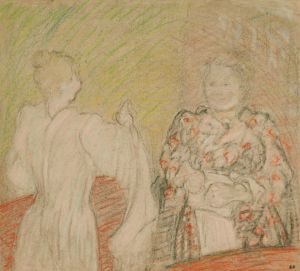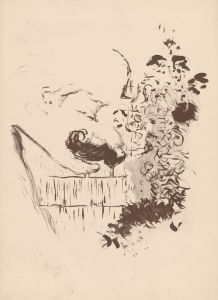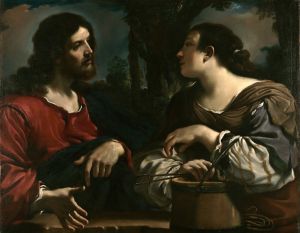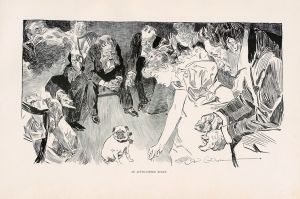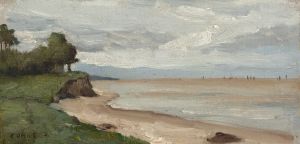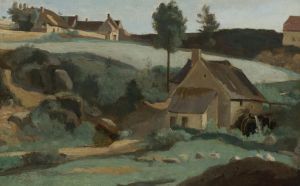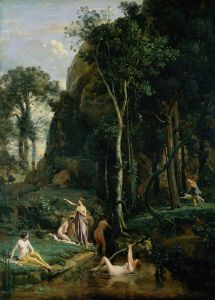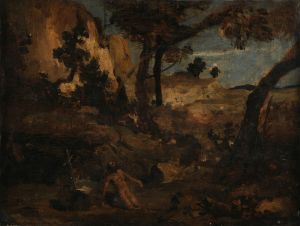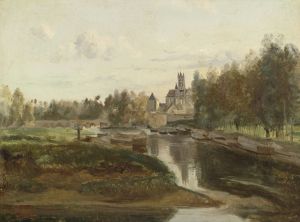
Trois Paysannes Causant Dans Une Cour Rustique
A hand-painted replica of Jean-Baptiste-Camille Corot’s masterpiece Trois Paysannes Causant Dans Une Cour Rustique, meticulously crafted by professional artists to capture the true essence of the original. Each piece is created with museum-quality canvas and rare mineral pigments, carefully painted by experienced artists with delicate brushstrokes and rich, layered colors to perfectly recreate the texture of the original artwork. Unlike machine-printed reproductions, this hand-painted version brings the painting to life, infused with the artist’s emotions and skill in every stroke. Whether for personal collection or home decoration, it instantly elevates the artistic atmosphere of any space.
Jean-Baptiste-Camille Corot was a pivotal figure in landscape painting and is often associated with the Barbizon School, a movement that laid the groundwork for Impressionism. His work, "Trois Paysannes Causant Dans Une Cour Rustique" (Three Peasant Women Chatting in a Rustic Courtyard), is an exemplary piece that showcases his ability to blend realism with a poetic sensibility.
Corot was born in Paris in 1796 and began his artistic career relatively late, after working in the family textile business. He studied under Achille-Etna Michallon and Jean-Victor Bertin, both of whom were proponents of the neoclassical tradition. However, Corot's style evolved to incorporate a more naturalistic approach, influenced by his travels through Italy and his exposure to the landscapes of the French countryside.
"Trois Paysannes Causant Dans Une Cour Rustique" is a testament to Corot's mature style, characterized by a harmonious balance between figures and their environment. The painting depicts three peasant women engaged in conversation within a rustic courtyard setting. The composition is simple yet effective, with the figures arranged in a manner that draws the viewer's eye into the scene. Corot's use of light and shadow is subtle, creating a tranquil atmosphere that underscores the everyday nature of the subject matter.
Corot's technique in this painting reflects his mastery of tonal variation and his ability to capture the nuances of natural light. The color palette is muted, dominated by earthy tones that enhance the rustic theme. The figures are rendered with a gentle realism, their postures and expressions conveying a sense of ease and familiarity. This approach is indicative of Corot's broader artistic philosophy, which sought to depict the beauty of ordinary life without embellishment or dramatization.
The painting also exemplifies Corot's skill in integrating figures into the landscape, a hallmark of his work. The courtyard setting is depicted with a keen attention to detail, from the texture of the walls to the play of light on the ground. This integration of figures and setting is seamless, reflecting Corot's belief in the interconnectedness of humans and nature.
Corot's influence on subsequent generations of artists cannot be overstated. His work bridged the gap between the neoclassical and romantic traditions and the emerging Impressionist movement. Artists such as Claude Monet and Camille Pissarro admired Corot for his innovative approach to landscape painting and his ability to convey mood and atmosphere through subtle tonal variations.
"Trois Paysannes Causant Dans Une Cour Rustique" is a fine example of Corot's contribution to the development of modern art. It encapsulates his unique vision and his dedication to capturing the essence of the natural world and the people within it. Through his work, Corot not only documented the landscapes and rural life of his time but also paved the way for future explorations of light, color, and form in painting.
In summary, Jean-Baptiste-Camille Corot's "Trois Paysannes Causant Dans Une Cour Rustique" is a significant work that highlights the artist's skill in blending realism with a poetic sensibility. The painting's depiction of peasant life, its harmonious composition, and its subtle use of light and color exemplify Corot's influence on the evolution of landscape painting and his enduring legacy in the art world.






